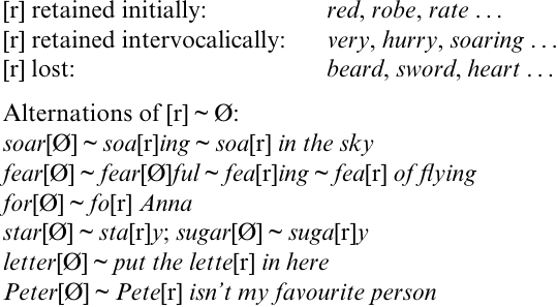
English /r/: a brief outline
 المؤلف:
APRIL McMAHON
المؤلف:
APRIL McMAHON
 المصدر:
LEXICAL PHONOLOGY AND THE HISTORY OF ENGLISH
المصدر:
LEXICAL PHONOLOGY AND THE HISTORY OF ENGLISH
 الجزء والصفحة:
P231-C6
الجزء والصفحة:
P231-C6
 2024-12-26
2024-12-26
 1132
1132
English /r/: a brief outline
Accents of English fall into two broad groupings (with some further refinements, as we shall see) with respect to /r/. The actual phonetic realization of /r/ is not constant across all varieties: it is very frequently an alveolar or post-alveolar approximant, but may be a tap, especially initially or intervocalically, in Scottish varieties, or an r-colored schwa in some contexts in General American. There are also pockets of uvular fricatives [ʁ] in Aberdeen, and among older speakers in Northumberland and Durham (Wells 1982, Lass 1987: 94); and the labio-dental approximant [ʋ] is increasingly common in urban areas (Foulkes 1997). Although issues of phonetic realization will be of some concern below, when we turn to the history of /r/, synchronically they are not of central importance; for convenience, I shall therefore generally use [r] notation, not to indicate an alveolar trill, but as shorthand for the various realizations of /r/ found across the accents of English.
In rhotic accents, [r] is pronounced in all possible phonological contexts: word-initially, as in red; intervocalically, as in very; finally, as in letter; and in clusters, as in bread or herd. As a rule of thumb, [r] surfaces wherever there is an in the spelling. Furthermore, in rhotic accents, the set of vowels which can occur before /r/ tends to be identical, or near identical, to that found before other consonants or word-finally: thus, in Scottish Standard English (SSE), the vowels in bee and beer are phonologically the same, giving /bi/ and /bir/. Likewise, SSE speakers have /e/ in hay and /er/ in hair; /a/ in spa and /ar/ in spar;/ɔ/ in law and /ɔr/ in north; /o/ in foe and /or/ in four; and /u/ in queue and /ur/ in cure. Irish, Scottish and Canadian English, as well as General American, some English English accents, and some Caribbean varieties, are rhotic (Wells 1982); but the vowel inventories found before /r/ vary considerably across dialects, and limited mergers, such as the American merry = marry = Mary, do occur. [r]-loss is also still in progress in some areas: Romaine (1978) reports a final zero variant for some working class Edinburgh schoolchildren, most commonly in her male informants, while Sullivan (1992) documents rapidly decreasing rhoticity for younger urban speakers in Exeter.
Non-rhotic accents are found in England, Wales, the Eastern and Southern states of the USA, Australia, New Zealand and South Africa. Here, [r] does not surface synchronically in all phonological contexts, or in all forms with orthographic . Historical [r] is retained word initially and intervocalically, but has been lost pre-consonantally and pre-pausally, so that [r] appears in red, very and bread, but not in herd or letter. Furthermore, in non-rhotic accents, the inventory of non-low vowels before historical [r] tends to differ from those found elsewhere: beer, hair, four and cure will typically have centring diphthongs, with a schwa offglide, while bee, hay, foe and queue have /i:/, /eɪ/, /oʊ/ and /u:/.
There is also a merger of short /ɪ ε Λ/ before historical /r/, typically as [з:], so that Scots bird, herd, word [bɪrd], [hεrd], [wΛrd] correspond to RP (and other non-rhotic) [bз:d], [hз:d], [wз:d].
In many non-rhotic varieties, alternations of [r] and ∅ in simple and derived forms within the same paradigm have arisen because of the retention of historical [r] pre-vocalically but its loss finally and preconso nantally; examples are given in (1).
(1) 
This alternating, etymological [r], in derived intervocalic contexts either word-internally or across word-boundaries, is known as linking [r]. It is present in most non-rhotic accents, but rather infrequent in South Africa and the Southern States of the USA, a fact to which we shall return below. In the Southern USA, /r/ may also optionally be elided intervocalically, giving Carolina [kæ'lanə] and very [vε:ɪ].
A further development in non-rhotic accents other than those of the Southern USA and South Africa involves so-called intrusive [r]. This unetymological [r] appears intervocalically, again word-internally and across word-boundaries, in the same environments as linking [r].
Let us turn now to the question of how these non-rhotic varieties arose, and how they are best accounted for in synchronic terms.
 الاكثر قراءة في Phonology
الاكثر قراءة في Phonology
 اخر الاخبار
اخر الاخبار
اخبار العتبة العباسية المقدسة


